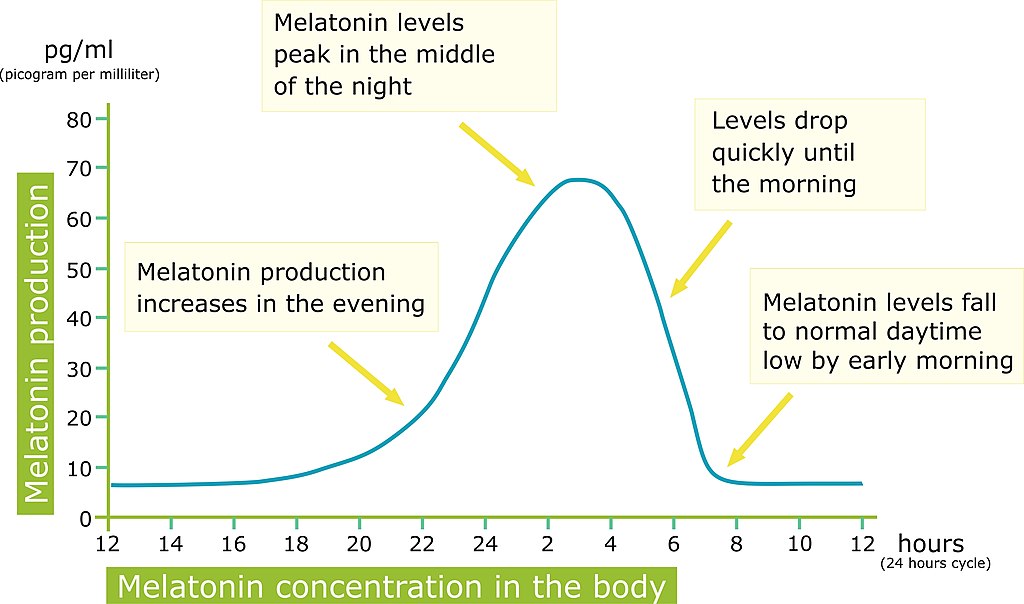You might be shocked to learn that the answer is yes. Let’s discuss how, why, and what we can do about it. It all comes down to melatonin.
Over the last few decades there has been lots of compelling research done on circadian rhythms (our natural body clocks being in sync with natural 24 hour day rhythms). As daylight wanes into night, our body’s production of melatonin increases until the morning when light returns. A normal melatonin cycle is pictured below.

Why is that so important? Well, melatonin is an important hormone made in a tiny gland in our brain, which regulates all our other hormones and our 24 hour body cycle, also known as our circadian rhythm. I first learned about circadian rhythms during my biology studies in college and was fascinated by an experiment that showed a single exposure to bright light (say in going to the bathroom in the middle of the night) could crash your body’s melatonin and completely disrupt your sleep cycle. In essence, restarting the melatonin cycle all over again. It stuck with me to this day that I rather take the risk of stubbing my toes in the dark, than turn on the light.
Years later, there was a study done on healthy preschoolers that showed that compared to the previous night with no light exposure before bedtime, there was a 70–99% reduction in melatonin by just being exposed to low level light before bedtime. Say by looking at a television or iPad screen. They did not correlate this to crankiness the next day, but I’d bet in both adults and preschoolers, you would find it.
Beyond crankiness, extended disruption to your circadian rhythm has many real life negative health effects including obesity, depression, and yes, cancer. I became very interested in this topic again years after graduating, because I had taken on a role of an overnight operations manager. Knowing a little about sleep disruption, I did some more research. One thing I was surprised to learn was that shift work (one of the largest reasons for circadian disruption at the time) was considered a known possible carcinogen by the World Health Organization (WHO), and further in 2019 was classified not just as possible, but a known independent risk factor for cancer by the American Association of Cancer Research.
It is unlikely that it is the night work itself, but more the continuous disruption of the sleep cycle. Like most night shift workers, when I worked night shifts, I would work at night and sleep during the day for 3–4 days a week, and then flipped back to sleeping at night and staying awake during the day on my off days. This reversal of circadian rhythms (at least 2x a week) can wreak havoc on your body’s biological clock.
So, while many people, especially in corporate environments, do not work night shifts, they ARE engaging more and more with circadian disruption through use of their electronic devices at night. It can probably be argued that minor sleep disruption by watching tv or scrolling on your phone at night is less carcinogenic than actual full nighttime sleep disruption. I would caution, however, that there is now starting to be quite a link between screen time and obesity.
In a recent article about the potential to use light therapy to lose weight, Dr. Michael Greger, M.D., writes that “Using wrist meters to measure ambient light exposure, researchers found that increased exposure to light in the evening and night time correlated with a subsequent increased risk of developing obesity over time. This was presumed to be due to circadian misalignment, but might it instead be a sign of not sleeping as much, and maybe that’s the real reason people grew heavier? This was controlled for in a study of more than 100,000 women, which found that the odds of obesity trended with higher nighttime light exposure independent of sleep duration.” It wasn’t the amount of sleep, but the disruption of it.
So, what do we do about it? Well, knowing that our nighttime scrolling habit has severe consequences over time is the first step. From there, we can mindfully put in place nighttime routines that help us stay fitter and healthier longer. A good general practice is to end screen time at least one hour before bedtime. If you have dimmable lights, it’s also a good idea to dim the lights, or use lamps instead of overhead lights. I recently got a daylight alarm clock for Mother’s Day (because I ask for weird health gadgets ;)). The nice thing is that it also doubles as a night light using red spectrum light. Or, if you are a night time reader, most iPhone, kindles, and iPads, also now have blue light blocking settings. And if you are really serious about reducing the risks, you can use complete blue light blocking glasses or simply read a good old fashioned paper book to candle light. What a nice way to end your evening.
Additional things that help with a good night’s sleep include darkening shades on the windows (especially in an urban environment where there is a lot of light on the street). Alternatively, you could use a sleep mask. Eating earlier in the evening and not right before bedtime. And last but not least, keeping your room a cool 67–68 degrees F. More on temperature and its effect on sleep another time, but this has been shown to be the ideal temp for sleep. A few simple tweaks to your nighttime routine can help to reduce your susceptibility to obesity and even cancer.
Yvonne Lee-Hawkins, IPHM, is a holistic wellness coach, stress strategist, and writer. She has tried and tested countless health and wellness strategies to help her deal with the relentless pressures of her former high achieving corporate career and motherhood. When she is not working, she loves to go on adventures with her family, in the Pacific Northwest where they call home. You can find out more on her website, or follow her on LinkedIn, Medium, or Instagram.
